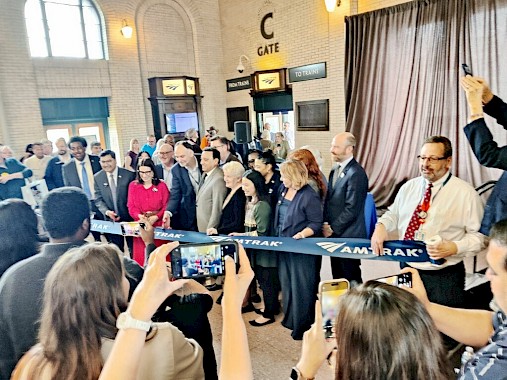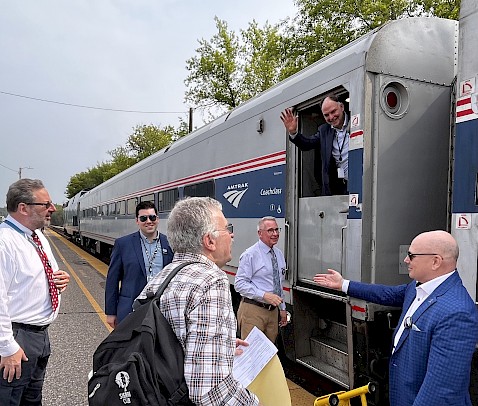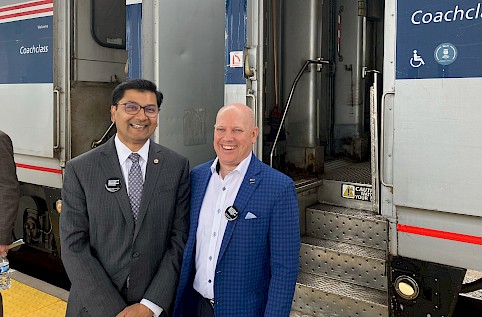Happening Now
Borealis: A Long-Awaited Victory Lap
May 22, 2024
By Jim Mathews / President & CEO
Amtrak’s Borealis pulled out of St. Paul Union Depot in Minnesota yesterday at 11:45 am after an exciting morning of speeches, congratulations, and even a cameo by Sen. Amy Klobuchar (D-Minn.) appearing via iPhone held up to the podium microphone by a staffer.
I was incredibly fortunate that Amtrak invited me to ride that first run, along with Federal Railroad Administration Administrator Amit Bose, Amtrak CEO Stephen Gardner, AFL-CIO Transportation Trades President Greg Regan, and top executives from across Amtrak – many of whom, like Derrick James from Amtrak Government Affairs, have spent many years working to get this launched – and from host railroad CPKC.
We also boarded Mayors, state legislators, and local transportation officials. Wisconsin Gov. Tony Evers (D) hopped on in La Crosse after a ceremonial ribbon-cutting there and rode a few stops before leaving the train in Tomah. Also getting on with the governor was Arun Rao, now director of Network Development at Amtrak, who was one of those early pioneers in this effort when he was still with the Wisconsin Dept. of Transportation and chair of the States for Passenger Rail coalition.

Despite the threat of tornados, heavy winds, and flooding – we crawled along with weather-driven slow orders for the first 45 minutes of the trip – the atmosphere on board the first car where we were all seated was the same mix of giddy excitement and fun that you might expect on a high-school senior trip. Everyone was so happy to be there, and to see this train finally realized in revenue service. It was a well-deserved victory lap.
But I think the strongest impression I got from the day’s festivities was very similar to what I felt in 2016 when I rode the inspection train through the Gulf Coast from New Orleans to Jacksonville. Communities large and small came out to cheer the train, its crew, and even its passengers, waving signs and flags, passing out goodies from local eateries, and taking pictures as mayors and community leaders hoisted comically large scissors to snip Amtrak-themed ribbons trackside.

That’s because as much fun as yesterday’s celebration was, it was also the start of something incredibly powerful and meaningful to the communities that will be served on this new route. Midday, daylight service between not just St. Paul and Chicago, but from places like Red Wing or Winona to the vacation attractions of Wisconsin Dells, or even Columbus to the Milwaukee Airport.
Initial ridership estimates suggest the train will produce more than 250,000 passengers every year, with somewhere between 15,000 or as many as 25,000 being coaxed to make trips they might not otherwise have made. Those trips alone will generate some $4 million in tourism revenue, and overall the Borealis is likely to inject at least $50 million or more into the economies of Minnesota, Wisconsin, and Illinois annually.
Small businesses have launched in and around the train stations already in anticipation of yesterday’s service launch. People turned up all along the route to share their excitement. The Mayor of Winona told me that with their university complex expanding, they’ve already built a transportation plan for students with this new service in mind.
To be sure, there were teething pains. I spoke with a Ramsey County official (where St. Paul is located) about the need for Red Caps at the station to help disabled and elderly passengers. She pointed all the way down the expansive train hall, noting that it’s already a long walk from the platform and when “you turn right and see how much longer you have to go” it can be discouraging. The Chicago terminus staff seemed a little confused about their new train and its passengers. Demand-driven algorithms are already pushing holiday-weekend fares well past the $41 advertised as the Borealis’ base rate.

But those are problems with solutions. And this team has had to work out solutions to lots of thorny problems just to get this far. This was much more than just “running a Hiawatha [train] a little longer.” This is a new service paid for by three states, which meant three sets of negotiations, a lot of give and take, and the extra complication of bringing in a state – Minnesota – which had never had state-supported Amtrak service before. Now that there’s a blueprint, everyone involved hopes the next new frequency will be a lot easier to pull off.
Meanwhile, if those folks on the platforms in Red Wing, Winona, La Crosse, Tomah, Wisconsin Dells, Portage, and Columbus are any indication, I think tickets will be going fast for quick getaways this summer. Go take a ride and see for yourself!
"On behalf of Amtrak’s onboard service staff, I want to thank the Rail Passengers Association for honoring their hard work with this award. The past couple years have indeed been difficult for Amtrak onboard service staff – coping with furloughs and job insecurity, adapting to changing protocols and services, not to mention the unfortunate events such as a tragic derailment and a fatal shooting. Nevertheless, our dedicated members at Amtrak have handled these hurdles with the care, attention and diligence for which they’re known. We thank Rail Passengers for their acknowledgement of our members’ hard work and, as always, look forward to seeing you on the rails."
Arthur Maratea, TCU/IAM National President
December 21, 2021, on the Association awarding its 2021 Golden Spike Award to the Frontline Amtrak Employees.
Comments